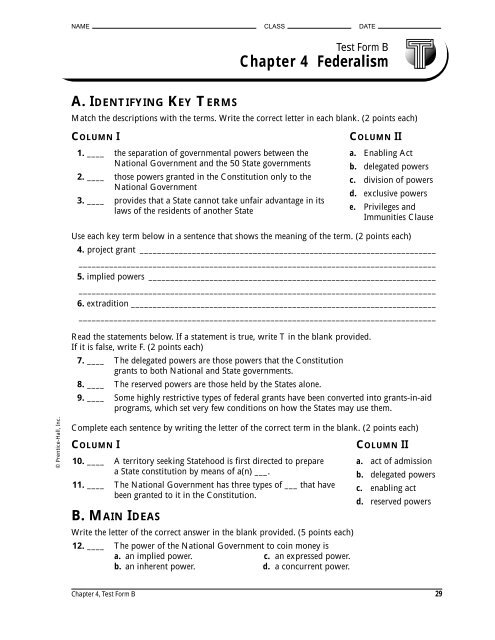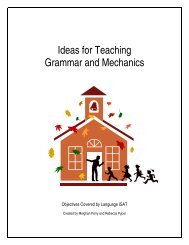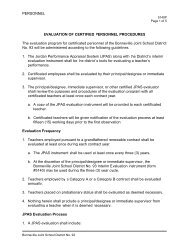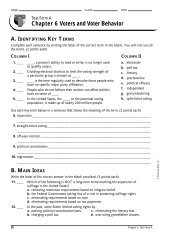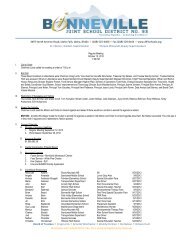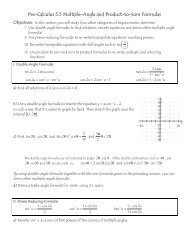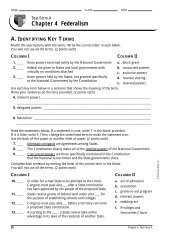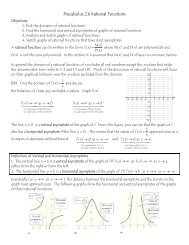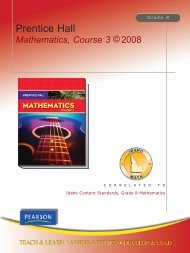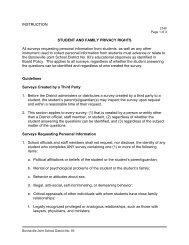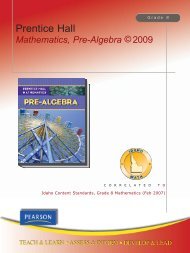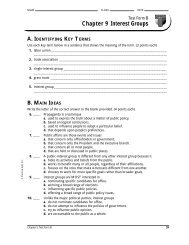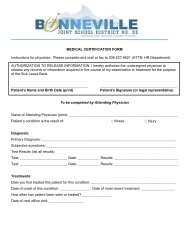Chapter 4: Test Form B
Chapter 4: Test Form B
Chapter 4: Test Form B
You also want an ePaper? Increase the reach of your titles
YUMPU automatically turns print PDFs into web optimized ePapers that Google loves.
NAME CLASS DATE<strong>Test</strong> <strong>Form</strong> B<strong>Chapter</strong> 4 FederalismA. IDENTIFYING KEY TERMSMatch the descriptions with the terms. Write the correct letter in each blank. (2 points each)COLUMN I1. ____ the separation of governmental powers between theNational Government and the 50 State governments2. ____ those powers granted in the Constitution only to theNational Government3. ____ provides that a State cannot take unfair advantage in itslaws of the residents of another StateCOLUMN IIa. Enabling Actb. delegated powersc. division of powersd. exclusive powerse. Privileges andImmunities ClauseUse each key term below in a sentence that shows the meaning of the term. (2 points each)4. project grant ______________________________________________________________________________________________________________________________________________________5. implied powers ____________________________________________________________________________________________________________________________________________________6. extradition ________________________________________________________________________________________________________________________________________________________Read the statements below. If a statement is true, write T in the blank provided.If it is false, write F. (2 points each)7. ____ The delegated powers are those powers that the Constitutiongrants to both National and State governments.8. ____ The reserved powers are those held by the States alone.9. ____ Some highly restrictive types of federal grants have been converted into grants-in-aidprograms, which set very few conditions on how the States may use them.© Prentice-Hall, Inc.Complete each sentence by writing the letter of the correct term in the blank. (2 points each)COLUMN ICOLUMN II10. ____ A territory seeking Statehood is first directed to preparea State constitution by means of a(n) ___.a.b.act of admissiondelegated powers11. ____ The National Government has three types of ___ that have c. enabling actbeen granted to it in the Constitution.d. reserved powersB. MAIN IDEASWrite the letter of the correct answer in the blank provided. (5 points each)12. ____ The power of the National Government to coin money isa. an implied power. c. an expressed power.b. an inherent power. d. a concurrent power.<strong>Chapter</strong> 4, <strong>Test</strong> <strong>Form</strong> B 29
NAME CLASS DATE<strong>Test</strong> <strong>Form</strong> B<strong>Chapter</strong> 4 Federalism13. ____ Which of the following powers can the National Government legally exercise?a. expressed powers onlyb. expressed, implied and inherent powersc. delegated and reserved powersd. powers not granted to the States14. ____ Which of the following is NOT among the obligations that theNational Government has to the States?a. protection against foreign attack and domestic violenceb. guarantee of a representative form of governmentc. recognition of each State’s legal existence and physical boundariesd. recognition of State constitutions as the supreme law of the land15. ____ From the States’ point of view, what advantage did revenue sharing have overfederal grants-in-aid programs?a. establishment of land-grant collegesb. few restrictions on how money could be spentc. federal control over policy mattersd. FBI expertise and assistance16. ____ Agreements States enter into with both foreign nations and other Stateswith the consent of Congress area. interstate compacts. c. extraditions.b. acts of admission. d. enabling acts.17. ____ Which of the following is the basic characteristic of federalism?a. It divides power between a National Government and State governments.b. It gives most power to the National Government.c. It gives most power to local units of government.d. It encourages citizen participation in government.18. ____ Which statement about local government is accurate?a. Local government has no relationship with State goverments.b. Local government is an extension of the federal government.c. Local government is a subunit of State government.d. Local government supercedes the authority of State government.19. ____ In the case of McCulloch v. Maryland, what was the Supreme Court ruling based upon?a. reserved powers c. Supremacy Clauseb. Full Faith and Credit Clause d. interstate compacts© Prentice-Hall, Inc.20. ____ The Full Faith and Credit Clause of the Constitution provides thata. Congress may not pass laws that conflict with State laws.b. State laws must be uniform.c. State laws and court decisions must generally be honored by other States.d. agreements made between the States must first be approved by Congress.30 <strong>Chapter</strong> 4, <strong>Test</strong> <strong>Form</strong> B
NAME CLASS DATE<strong>Test</strong> <strong>Form</strong> B<strong>Chapter</strong> 4 Federalism21. ____ Funds given to a State by the National Government with special conditionsattached are examples ofa. block grants. c. categorical grants.b. revenue sharing. d. project grants.C. INTERPRETING DIAGRAMSUse the diagram to answer the following questions.Write the correct answer in the blank provided. (4 points each)The Division of Powers Between the National Government and the StatesA Delegated Powers of theNational GovernmentBCACBDFEPowers denied the StatesDEF© Prentice-Hall, Inc.22. ____ What label should appear at the place marked by the letter F?a. Concurrent Powersb. Powers reserved to the Statesc. Powers denied both the National Government and the Statesd. Powers denied the National Government23. ____ The label Powers reserved to the States belongs at the place marked bya. the letter F. b. the letter B. c. the letter C. d. the letter D.24. ____ The label Powers denied to the National Government should be placed ata. the letter E. c. the letters C and F.b. the letters D and B. d. the letter D.D. CRITICAL THINKINGAnswer the following questions on the back of this paper or on a separate sheet of paper.(8 points each)25. Recognizing Ideologies How do the admission procedures for new States reflect theunderlying values of the Constitution?26. Identifying Central Issues Why did the Framers of the Constitution choose to create a systemof government based on federalism?<strong>Chapter</strong> 4, <strong>Test</strong> <strong>Form</strong> B 31


